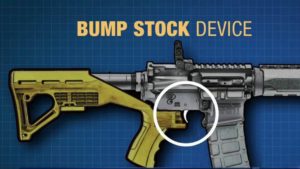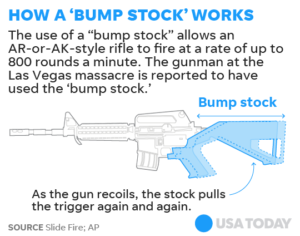Mar
4
Problems with Banning Bump Stocks
“By the way, bump stocks — we’re writing that out. I’m writing that out myself. I don’t care if Congress does it or not. I’m writing it out myself, okay? You put it into the machine-gun category, which is what it is. It becomes, essentially, a machine gun. And nobody’s gonna be able — it’s gonna be very hard to get ’em, so we’re writing out bump stocks.” — President Donald Trump, at last week’s 2018 White House Business Session
So,… if Congress doesn’t outlaw bump stocks, the President is determined to ban them by executive fiat. This was accompanied by proposals “to harden our schools so that they’re less vulnerable to attack” and to resurrect America’s mental health laws, etc., while also criticizing the cowardly behavior of Broward deputies. (Note: Bump stocks were not used in the Parkland school shooting in Broward County, FL, but in last year’s Las Vegas massacre.)
 As summarized by Townhall‘s Chris Reeves:
As summarized by Townhall‘s Chris Reeves:
“The president concluded his list of proposals by issuing a vague statement in support of “common-sense measures that protect the constitutional rights of law-abiding Americans while keeping guns out of the hands of those who pose a threat to themselves, and to others” (presumably referring to people who are dangerously mentally ill) and calling for the creation of a national culture “that cherishes life and condemns violence and embraces dignity.””
We all know that changes need to be made, and it’s good to see the president taking the matter seriously. Unfortunately, not all the advice he is getting is sound. Let’s go back to the proposed bump stock ban, for example. This isn’t a strictly partisan issue, and I’m actually sympathetic to the idea. But, does this really make sense? The Bureau of Alcohol, Tobacco, Firearms, and Explosives (ATF), has argued against it. As per Stefan Becket at CBS News,
“In 2010, the ATF determined that the devices don’t violate a longstanding federal ban on automatic weapons, given the specifics of how they actually work. Only a handful of states have laws on the books dealing with bump-fire stocks or similar devices meant to speed up a semi-automatic rifle’s rate of fire. The state laws that do regulate them have largely been untested in court.”
Trump appears resolute in moving forward, though, and the Dept. of Justice thinks they have a workable strategy:
“[W]e have had to deal with previous ATF legal opinions, but our top people in the Department of Justice have believed for some time that we can through regulatory process not allow the bump stock to convert a weapon from a semiautomatic to a fully automatic.” (Att. Gen. Jeff Sessions)
The NRA, somewhat surprisingly, is on record as being in favor of increased regulations on bump stocks but not a full ban. In fact, they want the ATF to handle the bump stock issue. According to CNN‘s Chris Cillizza,
“Several senior GOP sources tell CNN’s Phil Mattingly that the ATF option is the preferred route for leadership in both chambers right now.”
With that in mind, I turn to last week’s contributor, Brett K., for some thoughts on why a bump stock ban is a bad idea.
—
“On Banning Bump Stocks”
Trump is now supporting a ban on bump stocks. What could be wrong with that? Read on.
A bump stock is a stock you attach to a semi-automatic rifle. If you hold the rifle properly, the bump stock allows the gun to keep firing until you release the trigger. The Las Vegas shooter used bump stocks.
Bump stocks sound like a bad thing. Most people would agree with a ban. They let you fire a semi-automatic rifle much faster than normal. Personally, I have no interest in owning one. So what’s the problem?
1. You don’t need a bump stock to bump fire a rifle. You can bump fire a rifle by holding it a certain way.
Here’s a video of Tim from the Military Arms Channel bump firing a semi-automatic rifle. This is *not* a machine gun or assault rifle. It is a 100% legal semi-automatic rifle. It does *not* have a bump stock, yet he can still bump fire it. (You might want to jump to about 4m45s in.)
2. The current legislation seeking to ban bump stocks is worded too generally. They want to regulate “rate increasing devices”. A semi-automatic action in a rifle is a rate increasing device. Your finger is a rate increasing device.
3. This would set a precedent that semi-automatic rifles can only be fired at a certain rate. How could this be enforced? Is the ATF going to watch how fast every firearm owner in the U.S. pulls the trigger?
4. Once a bump stock ban is passed, the next step would be to ban all semi-automatic rifles. A semi-automatic action is [itself] a “rate increasing device” and allows the rifle to be bump fired — even without a bump stock. Why should that be legal when bump stocks are not?
The ATF is the government agency responsible for enforcing firearm law. Here’s a video of an ATF inspector warning about the consequences of a bump stock ban.
Semi-automatic rifles are *not* machine guns. They are *not* assault weapons. They have been around for over a hundred years. Your grandfather most likely used one for hunting. Some look a little different now, but they all function the same.
A semi-automatic action does allow the average person to fire a rifle faster. Each trigger pull fires only one bullet, but the shooter does not have to manually cycle the rifle to load another round.
5. However, with practice, you can fire a bolt-action or lever-action rifle about as fast as a semi-automatic rifle. It takes a little more skill, but it can be done. Here is a video of a guy shooting 19th-century style firearms as fast as semi-automatics. (You might want to jump to about 20s in.)
He had to cock the hammer between each revolver shot. He had to cycle the lever-action between each rifle shot. He had to pump *and* load the shotgun between each shotgun shot. He was still as fast as a semi-automatic.
Therefore, limiting the rate of fire of semi-automatics, or banning them outright, won’t solve the problem.
6. The end-game for gun control activists is a ban on all firearms. Every little step sets a precedent to take further steps. One of the top gun-control advocates in the country, Sen. Dianne Feinstein, said an outright ban on all firearms is the ultimate goal. [Note: To be fair, I haven’t been able to verify that Feinstein’s quote was taken in context, but there have been indications for awhile that the Leftists do indeed want to eventually disarm American citizens. Check out these two articles re recent actions.]
Any firearm can be misused, so there are only three ways to dramatically reduce firearm deaths: abolish the Second Amendment, confiscate all 310 million firearms in the U.S., and ban the sale of all firearms. Congress must implement all three or it will not have the desired effect.
Remember, the firearm homicide rate is about 11,000 per year. What percentage of the 130 million U.S. firearm owners commit those homicides? What percentage of the 310 million firearms in the U.S. are used in those homicides? The answer to both is less than one ten thousandth of one percent — that’s four zeros after the decimal. The firearm homicide rate is already extremely low and has been dropping for twenty years.
7. A bump stock ban does not address the primary issue in almost all mass murders — mental health problems. It does not address the failure of the FBI to follow protocols. It does not address the failure in communication between government agencies. It does not address the lack of mental health reporting to the background check system. It does not address the Air Force not reporting 30% of their convictions to the background check system.
 We have laws on the books not being followed. Government agencies are not following protocols. The background check system is not being updated properly. People with mental health problems will still get weapons until we address these problems.
We have laws on the books not being followed. Government agencies are not following protocols. The background check system is not being updated properly. People with mental health problems will still get weapons until we address these problems.
Also, the worst school killing in U.S. history was committed with a bomb. A ban on bump stocks will do nothing to prevent something like that from happening again. People committed to murder find a way.
What you end up with is “security theater”. You restrict the rights of 99.9999% of firearm owners and do nothing to solve any of the real problems. Meanwhile, criminals will still get their hands on illegal firearms and use them to commit crimes.
Those are the problems with a bump stock ban. End of rant.
—
Not that cut-n-dry, is it? Bottom line, such a ban will likely have little impact on the real issues, but it will set precedent that gun-control activists would be able to use in their efforts to shred 2nd Amendment rights. And that would not be good for our nation’s future and the freedoms of young and old alike.















